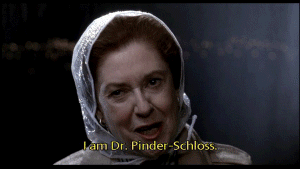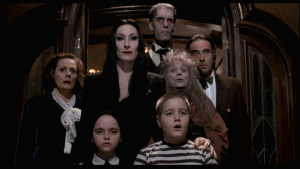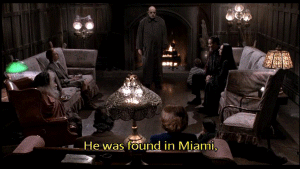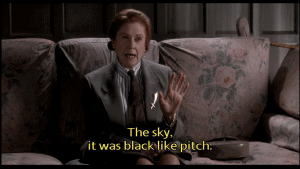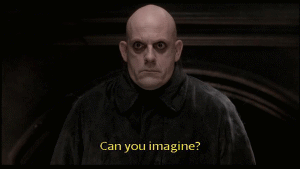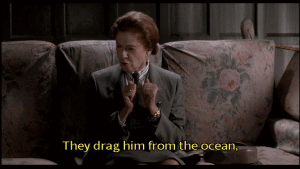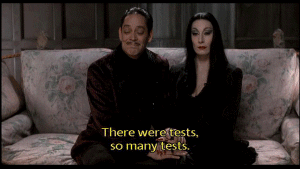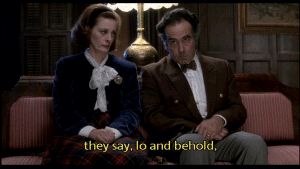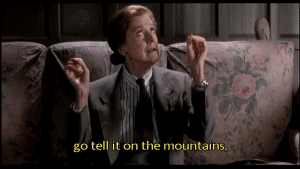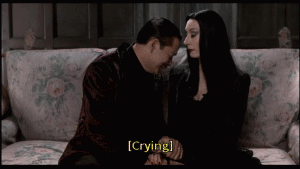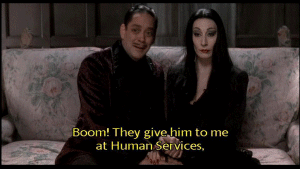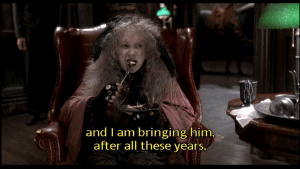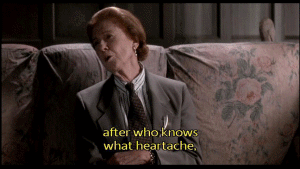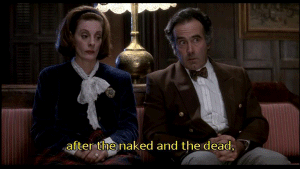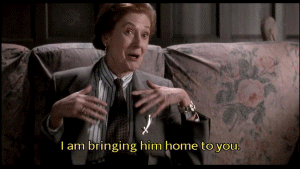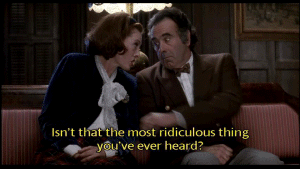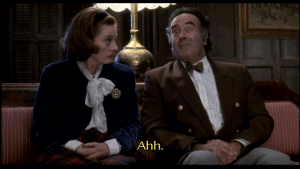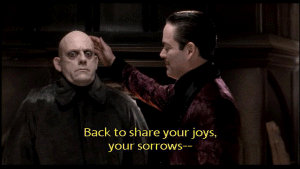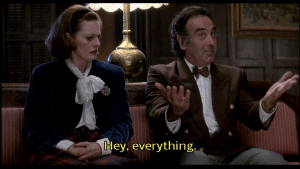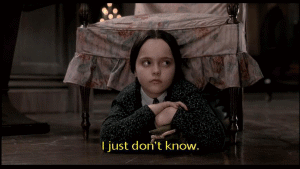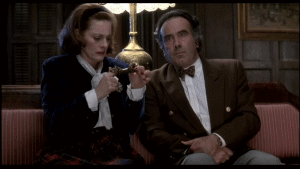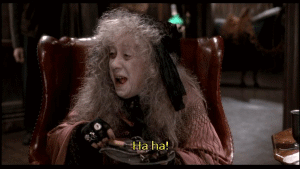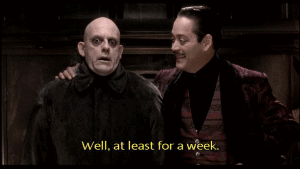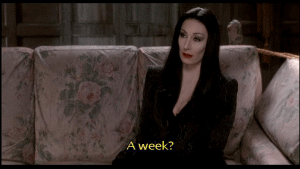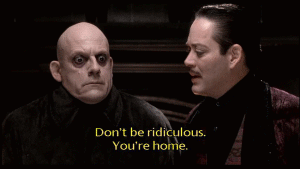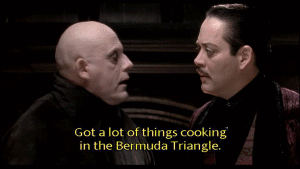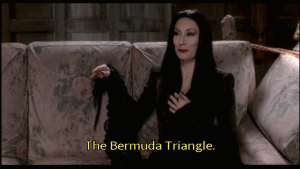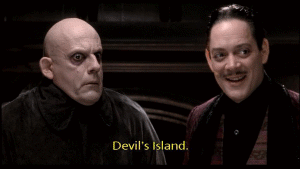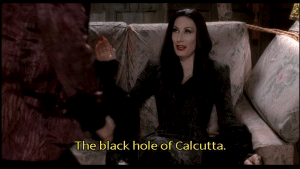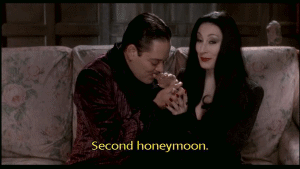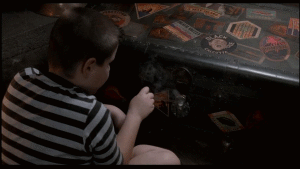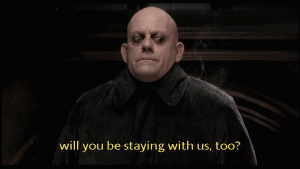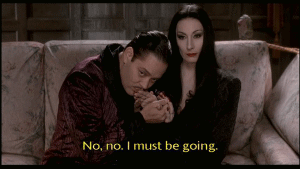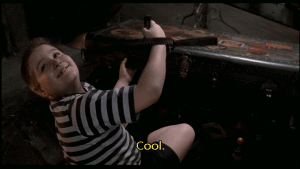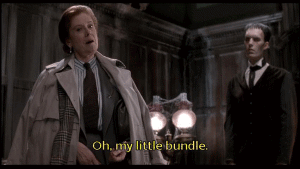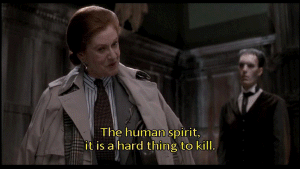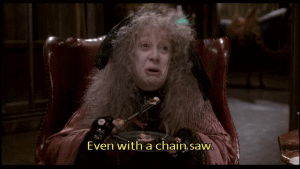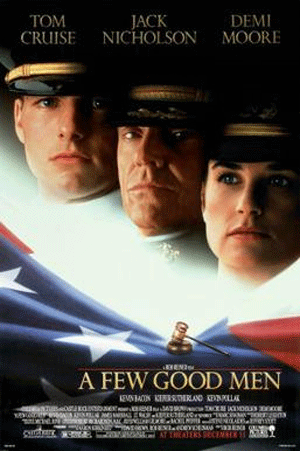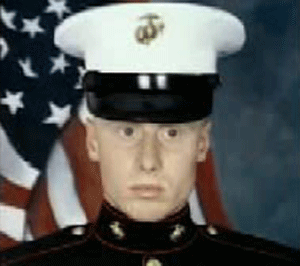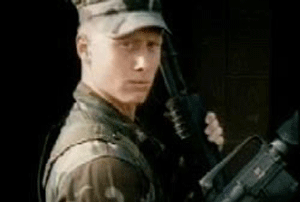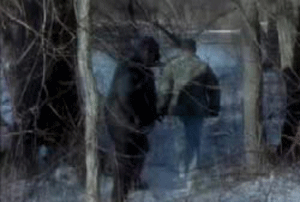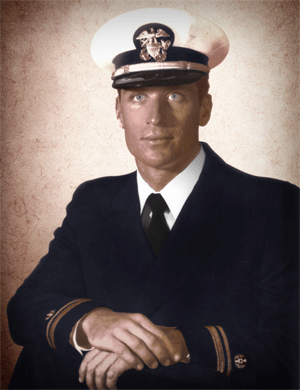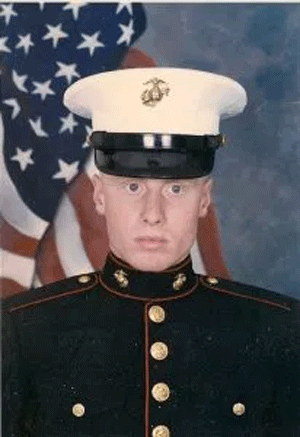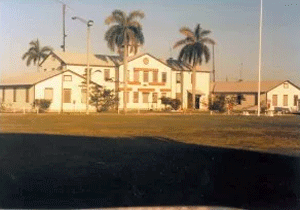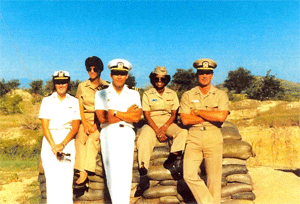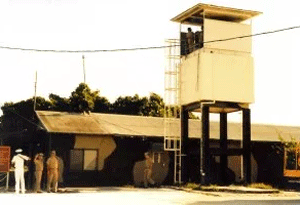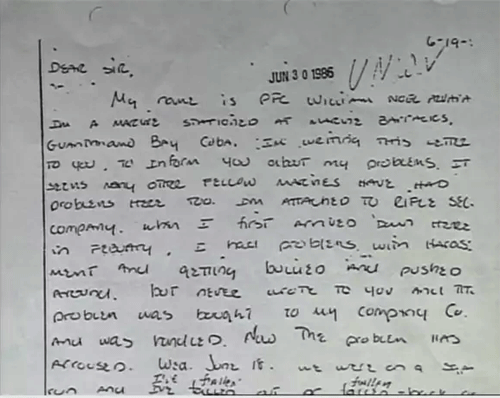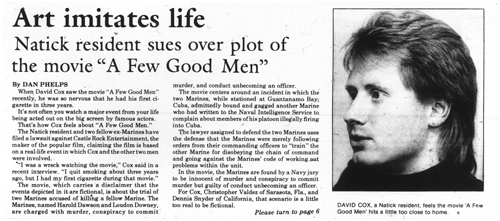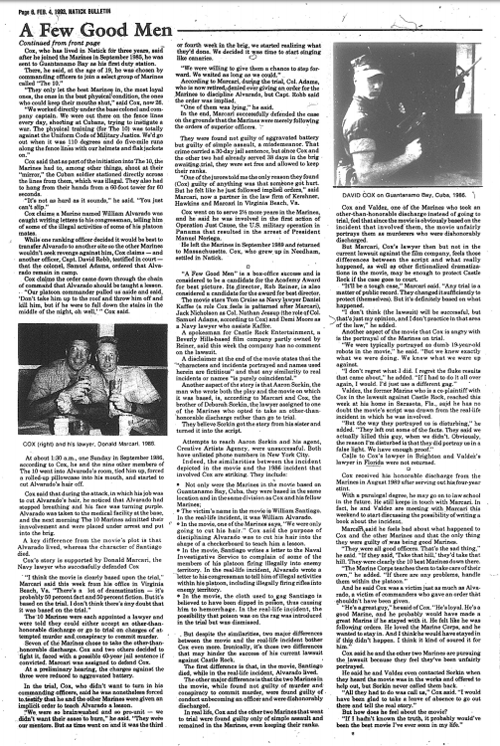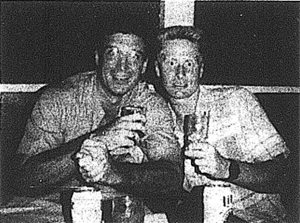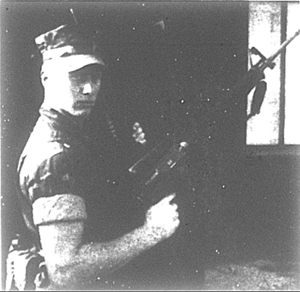Re: Mrs. Kay Griggs on How the Government Works
Military Necessity and Homosexuality: Our “New Gender Order” Is Not Fighting Fit
by Ronald D. Ray
Indiana Policy Review
August, 1993
NOTICE: THIS WORK MAY BE PROTECTED BY COPYRIGHT
The defense of the military ban against homosexuals rests historically and legally upon government deference, particularly by Congress and the federal courts and the U.S. Supreme Court, to the military on the basis of “military necessity.” Its singular mission is, as stated by the Secretary of Defense, on March 26, 1992, “to fight and win our wars,” to defend America from enemies foreign and domestic.
Anything or anyone who interferes with or inhibits the military’s ability to accomplish that high calling with the fewest casualties is a threat to national security. The military is an entirely separate society apart from the civilian society and necessarily governed by different rules and standards. Soldiers are recruited and selected from classified groups based on military selection criteria that were developed over time and proven on the battlefield. First and foremost the battlefield demands that young recruits between the ages of 18 to 26 be ablebodied. The military “discriminates” against classifications or groups such as convicted felons, non-high school graduates, drug users, the physically disabled, etc., because those groups have characteristics shown to be unfit for military service.
For example, there is absolutely no reason based upon military necessity’s battlefield standard to assign women, who as a group physically have one-third less strength, agility, speed and endurance than men, to the combat arms. This is especially true when the military is reducing forces and ample numbers of able-bodied men are available for combat service. The extraordinary physical demands of combat on land, sea and air are unchanging and are still critically important in war. Military leaders declare that the battlefield has not become less demanding because of today’s advanced technology, but rather more lethal.
There is also no sound military reason based upon this “military necessity” standard for allowing open homosexuals to serve in the military. In recent weeks the press has dealt with a variety of disruptions to the military’s good order and discipline raised by the possible elimination of the ban: morale and cohesion; lack of privacy; fraternization; favoritism; sexual harassment; etc. While these are important considerations, the decision is fundamentally flawed for one primary reason: The homosexuals are not as a group able-bodied. They are known to carry extremely high rates of disease brought on because of the nature of their sexual practices and the promiscuity which is a hallmark of their lifestyle.
Evidence to this fact abounds: The August 3, 1992, issue of Newsweek reported that 87 percent of all AIDS cases in adults over the age of 24 are attributable to drug use needle-sharing and male-to-male sex. Of AIDS patients aged 13 to 24, 77 percent admit to male-to-male sex. A compilation of recent health studies [1] shows that homosexuals account for 80 percent of America’s most serious Sexually Transmitted Diseases (STD); despite the fact that they account for less than 2 percent of the total American population. Youths engaging in homosexual behavior are 23 times more likely to contract a sexually transmitted disease than strictly heterosexual you6ths. Lesbians are 19 times more likely than heterosexual women to have had syphilis, twice as likely to suffer from genital warts, and four times as likely to have scabies. Male homosexuals are 14 times more likely to have had syphilis than male heterosexuals. They are also thousands of times more likely to contract AIDS. According to the Centers for Disease Control, at least two-thirds of all AIDS cases in the United States are directly attributable to homosexual conduct. [2]
It is often argued by homosexual advocates that this destructive behavior is merely a reaction to society’s unwillingness to accept homosexuality. But San Francisco, with its open validation of homosexuality, has an overabundance of the social and medical woes associated with homosexuality.
If America’s elected officials permit homosexuals to openly serve in the military with America’s sons and daughters, knowing full well that homosexuals carry, in overwhelming numbers, a disease more deadly than war’s killing fields, they will answer to America’s families. To place American servicemen and women at risk with no military purpose or benefit is very, very wrong.
Homosexual Practices
Sexuality may be the most profound and powerful life force, requiring strong discipline and commitment to be channeled in healthy ways or it can become destructive and deadly. Early in the 1970s, Dr. William H. Masters of St. Louis announced to the nation’s press that homosexuality is “natural” and by direct implication a normal sexual act or sexual condition. In so doing, Dr. Masters had “raised the status of the anus to the level of the vagina. What was until then a purely excretory organ had become a genital one – by decree.” [4] With the onslaught of AIDS there has been a blizzard of educational information on “safe sex” precautions for homosexuals printed and disseminated largely with government funds. An understanding of homosexual practices drawn from information in the “safe sex” materials may prove helpful to America as it deliberates the suitability of homosexuals serving openly in the military.
Beside the general “gay” sexual practices of mutual masturbation and fellatio/cunnilingus, other homosexual practices which are common in the “lifestyle” are more bizarre: Anal intercourse that often causes tearing or bruising of the anus or rectal wall, which is only one cell thick and not designed for this extreme activity. [5] Anal penetration (penetration of the anus by hand, arm, or foreign objects) – In 1983, well over a third of homosexuals admitted to participating in “fisting” – the insertion of hands or arms through the anus. Anal penetration by large objects (including bottles, cucumbers, carrots, light bulbs, dildos and other such “toys”) greatly increases tearing, bruising, and the risk of infection. It also debilitates the sphincter muscles which control the anus and bowel movements. [6] According to one medical study, ‘fist fornication’ is becoming increasingly common. [7] About 80 percent of homosexuals regularly use their tongues to stimulate the anuses of their partners, thus ingesting biologically significant amounts of fecal matter. [8] According to one clinical study: 92 percent of these men reported that they practiced anilingus [rimming]. This practice is particularly associated with the high incidence among homosexuals of Hepatitis A and Hepatitis B. [9] About 30 percent of homosexuals admitted to having “showered” in the urine of others, and about 20 percent admitted to ingesting urine. About 15 percent said they regularly seek to be urinated upon, and over 8 percent said they regularly ingest it. [10] In the latest national random survey, 17 percent of homosexuals admitted to having eaten or handled the feces of their partners, and 12 percent reported to giving and receiving enemas for sexual pleasure. [11] Sadomasochism – At least a quarter of homosexuals admit to ritual domination of partners, which involves the use of physical force, violence, and sometimes mutilation as a sexual stimulant.
The focus of male homosexuals is upon the anus. Contact with feces is an anathema to soldiers. Every soldier’s first overnight in the field includes instruction in basic field sanitation, avoiding the diseases that come from mishandling feces – and yet the military is being asked to lift the ban on a classification of people whose sexual practices involve oral-anal contact, and the ingestion of human feces. The prohibitions against mishandling feces in the field date at least from biblical times.
Politically Correct Science
The military is fully aware that the reports for nearly 10 years show that AIDS is still spread predominately by male-to-male sex. Others in academia, science, popular entertainment and the media appear to have misled the Pentagon and the American people about the “harmlessness” of homosexuality. On the contrary, homosexuality is a grave threat to not only our nation’s health but also our national security in several ways. Almost all homosexuals engage in sexual practices involving degradation or humiliation rarely practiced by heterosexuals. [12] The degrading nature of such practices constitutes the real basis of the homosexual security threat as photographs or a video of a service member or of a civilian policy-maker in such an extremely compromising position makes them vulnerable to blackmail or extortion. [13]
A Department of Defense report by Theodore Sarbin entitled, “Homosexuality and Personal Security,” was leaked to the press in October 1991, by an openly homosexual Congressman. The press quoted the Sarbin study saying that gay conduct is “unrelated to moral character” and claimed that homosexual and heterosexual trustworthiness and conduct are “identical.” Sarbin’s assertion is astounding when sexual infidelity and promiscuity are at the core of homosexual behavior, and it is inherently hostile to the moral order America was founded upon.
The much ballyhooed Sarbin study is little more than a pro-homosexual polemic. Sarbin’s study ignores many facts, repeats falsehoods concerning the nature of homosexuality, offers sheer conjecture regarding the nature of opposition to homosexuality, automatically discounts scientific and moral arguments against homosexuality and overlooks counter-espionage case histories involving homosexuals who became traitors through blackmail. [14] Its list of references includes not a single source on the actual experience of intelligence services with homosexuality.
Also, Sarbin’s oft-cited authority, John Money, blatantly demanded legalized adult-child sex in the “man/boy love” journal Paedophilia. Sarbin authority, Bullough, is one of a score of social science editors of Paedophilia. [15]
“The love between men and boys is at the foundation of homosexuality,” [16] or so says a recent editorial in the Sentinel, San Francisco’s premier homosexual publication. A plank in the “gay rights” agenda of 1972 called for striking down the age of consent laws which would allow sexual relations between adults and children. An organization called the North American Man/Boy Love Association (NAMBLA) champions “intergenerational sex.” The Rene Guyon Society expresses its philosophy in its motto, “sex before eight or it’s too late.”
In spite of the flaws inherent in Sarbin’s work, the study has gone on to influence judges, legislators, civilians and military personnel to force change with regard to homosexuals and security clearances. The chairman of the House Intelligence Committee and others encouraged the director of the CIA to stop the long-standing practice of asking potential CIA employees in lie-detector tests whether they are homosexual and also stopped investigating sexual orientation when updating security clearances. The decision followed a 1991 study ordered by Mr. Gates and encouraged by Mr. McCurdy that found no case of a CIA employee’s ever having been blackmailed into committing espionage on account of homosexuality. [17]
Yet American agents in the CIA have been turned against their country after blackmail threats related to homosexual behavior. James Speyer Kronthal was entrapped by photographs of his sexual activity twice by hostile intelligence services – first by the Gestapo before World War II and later by the KGB while he was serving as the CIA’s station chief in Bern, Switzerland. [18] In Kronthal’s case, the absence of a ban on homosexuality would not have protected him from the blackmail which made him a traitor: the nature of Kronthal’s depravity was among other things a preference for young boys.
With the stakes so incredibly high, would homosexual leaders and their friends falsify data in order to gain ground? They did, as a matter of record, conceal health data from their own populations in San Francisco and New York during the early days of the AIDS epidemic.
The real connection between homosexual sexual practices and AIDS was squelched. Even gay leaders like Randy Shilts and Larry Kramer were outraged. One thing is certain: homosexuals would move rapidly forward in their quest for a new gender and sexual moral order if the military ban on homosexual behavior is lifted.
_______________
Notes:
Col. Ronald D. Ray, USMCR, is a senior fellow of the foundation. Ray currently is a reserve historian with the Marine Corps Historical Center, Washington, D.C., working on a project on Marine advisors in the Vietnam War in the period of 1954-1975. The foundation thanks First Principles, Inc., for permission to republish his essay.
1. H.W. Jaffe, and C. Keewhan, et al., “National Case-Control Study of Kaposi’s Sarcoma and Pneumocystis Carinii Pneumonia in Homosexual Men: Part 1, Epidemiological Results,” Annals of Internal Medicine, 99 (2), 1983, pp. 145-151; H.H. Handsfield, “Sexually Transmitted Diseases in Homosexual Men,” American Journal of Public Health, (9), 1981, pp. 989-990; Karla Jay and Allen Young, The Gay Report: Lesbians and Gay Men Speak Out About Sexual Experiences and Lifestyles (New York: Summit Books, 1979); Janet E. Gans, et al., America’s Adolescents: How Healthy Are They? (American Medical Association, 1990, p. 31.
2. “The HIV/AIDS Surveillance Report: Year-End Edition,” U.S. Department of Health and Human Services, Centers for Disease Control, National Center for Infectious Diseases, Division of HIV/AIDS, January, 1992, p. 9.
3. General Colin L. Powell, Chairman of the Joint Chiefs of Staff, letter to Rep. Patricia Schroeder, 6 May 1992.
4. Socarides, Beyond Sexual Freedom (New York: Quadrangle, 1977). p. 121.
5. Paul Cameron, Ph.D., Exposing the AIDS Scandal (Lafayette, LA: Huntington House, 1988), pp. 148-151.
6. Paul Cameron, Ph.D., “Sexual Orientation and Sexually Transmitted Diseases,” Nebraska Medical Journal, vol. 70, 1985, pp. 292-299; J.R. Daling, “Sexual Practices, Sexually Transmitted Diseases, and the Incidence of Anal Cancer,” New England Journal of Medicine, vol. 317, 1987, pp. 973-977.
7. Kingsley, “Colorectal Foreign Bodies, Management Update,” Diseases of the Colon and Rectum, (vol. 28. 1985), 941-44.
8. M.T. Schechter, “Changes in Sexual Behavior,” Lancet, vol. 1293, 1984.
9. Walters, “Sexual Transmission of Hepatitis A in Homosexual Men: Incidence and Mechanism,” New England Journal of Medicine, [vol. 302, 1980], pp. 435-38; and Hepatitis B in Homosexual Men, American Journal of Medicine, 3A-21S-3A-25S [1989].
10. Id.
11. Cameron, Exposing the AIDS Scandal, pp. 149-52.
12. Lorraine Day, M.D., AIDS: What the Government Isn’t Telling You; Palm Desert, Calif.: Rockford Press, 1991, pp. 106-136.
13. William R. Corson, et al., Widows (New York: Crown Publishers, 1989).
14. Theodore R. Sarbin, Ph.D., and Kenneth E. Karols, M.D., Ph.D., Nonconforming Sexual Orientations and Military Suitability, Washington, DC: Defense Personnel Security Research and Education Center, December 1988).
15. Judith Reisman & Edward W. Eichel, Kinsey, Sex and Fraud: The Indoctrination of a People (Lafayette, LA: Huntington House Publishers, 1990), pp. 23-24. See also Judith A.
16. “No Place for Homo-homophobia,” supra.
17. Commentary: Morton Kondracke, “Incoming fusillade … fired in haste?” The Washington Times, 25 November 1992.
18. William R. Corson, et al., Widows (New York: Crown Publishers, 1989).
Colonel Ray’s study has been abridged for publication in this journal. Members can receive a complete text by sending $2.50 to “At Issue: Military: care of the foundation.
by Ronald D. Ray
Indiana Policy Review
August, 1993
NOTICE: THIS WORK MAY BE PROTECTED BY COPYRIGHT
YOU ARE REQUIRED TO READ THE COPYRIGHT NOTICE AT THIS LINK BEFORE YOU READ THE FOLLOWING WORK, THAT IS AVAILABLE SOLELY FOR PRIVATE STUDY, SCHOLARSHIP OR RESEARCH PURSUANT TO 17 U.S.C. SECTION 107 AND 108. IN THE EVENT THAT THE LIBRARY DETERMINES THAT UNLAWFUL COPYING OF THIS WORK HAS OCCURRED, THE LIBRARY HAS THE RIGHT TO BLOCK THE I.P. ADDRESS AT WHICH THE UNLAWFUL COPYING APPEARED TO HAVE OCCURRED. THANK YOU FOR RESPECTING THE RIGHTS OF COPYRIGHT OWNERS.
“A frequent recurrence to fundamental principles is absolutely necessary to preserve the blessings of liberty, and to maintain a free government.”
-- Massachusetts Bill of Rights, 1780
The defense of the military ban against homosexuals rests historically and legally upon government deference, particularly by Congress and the federal courts and the U.S. Supreme Court, to the military on the basis of “military necessity.” Its singular mission is, as stated by the Secretary of Defense, on March 26, 1992, “to fight and win our wars,” to defend America from enemies foreign and domestic.
Anything or anyone who interferes with or inhibits the military’s ability to accomplish that high calling with the fewest casualties is a threat to national security. The military is an entirely separate society apart from the civilian society and necessarily governed by different rules and standards. Soldiers are recruited and selected from classified groups based on military selection criteria that were developed over time and proven on the battlefield. First and foremost the battlefield demands that young recruits between the ages of 18 to 26 be ablebodied. The military “discriminates” against classifications or groups such as convicted felons, non-high school graduates, drug users, the physically disabled, etc., because those groups have characteristics shown to be unfit for military service.
For example, there is absolutely no reason based upon military necessity’s battlefield standard to assign women, who as a group physically have one-third less strength, agility, speed and endurance than men, to the combat arms. This is especially true when the military is reducing forces and ample numbers of able-bodied men are available for combat service. The extraordinary physical demands of combat on land, sea and air are unchanging and are still critically important in war. Military leaders declare that the battlefield has not become less demanding because of today’s advanced technology, but rather more lethal.
There is also no sound military reason based upon this “military necessity” standard for allowing open homosexuals to serve in the military. In recent weeks the press has dealt with a variety of disruptions to the military’s good order and discipline raised by the possible elimination of the ban: morale and cohesion; lack of privacy; fraternization; favoritism; sexual harassment; etc. While these are important considerations, the decision is fundamentally flawed for one primary reason: The homosexuals are not as a group able-bodied. They are known to carry extremely high rates of disease brought on because of the nature of their sexual practices and the promiscuity which is a hallmark of their lifestyle.
Evidence to this fact abounds: The August 3, 1992, issue of Newsweek reported that 87 percent of all AIDS cases in adults over the age of 24 are attributable to drug use needle-sharing and male-to-male sex. Of AIDS patients aged 13 to 24, 77 percent admit to male-to-male sex. A compilation of recent health studies [1] shows that homosexuals account for 80 percent of America’s most serious Sexually Transmitted Diseases (STD); despite the fact that they account for less than 2 percent of the total American population. Youths engaging in homosexual behavior are 23 times more likely to contract a sexually transmitted disease than strictly heterosexual you6ths. Lesbians are 19 times more likely than heterosexual women to have had syphilis, twice as likely to suffer from genital warts, and four times as likely to have scabies. Male homosexuals are 14 times more likely to have had syphilis than male heterosexuals. They are also thousands of times more likely to contract AIDS. According to the Centers for Disease Control, at least two-thirds of all AIDS cases in the United States are directly attributable to homosexual conduct. [2]
It is often argued by homosexual advocates that this destructive behavior is merely a reaction to society’s unwillingness to accept homosexuality. But San Francisco, with its open validation of homosexuality, has an overabundance of the social and medical woes associated with homosexuality.
If America’s elected officials permit homosexuals to openly serve in the military with America’s sons and daughters, knowing full well that homosexuals carry, in overwhelming numbers, a disease more deadly than war’s killing fields, they will answer to America’s families. To place American servicemen and women at risk with no military purpose or benefit is very, very wrong.
Homosexual Practices
“Skin color is a benign, non-behavioral characteristic. Sexual orientation is perhaps the most profound of human behavioral characteristics. Comparison of the two is a convenient but invalid argument.” [3]
-- General Colin Powell, chairman of the Joint Chiefs of Staff.
Sexuality may be the most profound and powerful life force, requiring strong discipline and commitment to be channeled in healthy ways or it can become destructive and deadly. Early in the 1970s, Dr. William H. Masters of St. Louis announced to the nation’s press that homosexuality is “natural” and by direct implication a normal sexual act or sexual condition. In so doing, Dr. Masters had “raised the status of the anus to the level of the vagina. What was until then a purely excretory organ had become a genital one – by decree.” [4] With the onslaught of AIDS there has been a blizzard of educational information on “safe sex” precautions for homosexuals printed and disseminated largely with government funds. An understanding of homosexual practices drawn from information in the “safe sex” materials may prove helpful to America as it deliberates the suitability of homosexuals serving openly in the military.
Beside the general “gay” sexual practices of mutual masturbation and fellatio/cunnilingus, other homosexual practices which are common in the “lifestyle” are more bizarre: Anal intercourse that often causes tearing or bruising of the anus or rectal wall, which is only one cell thick and not designed for this extreme activity. [5] Anal penetration (penetration of the anus by hand, arm, or foreign objects) – In 1983, well over a third of homosexuals admitted to participating in “fisting” – the insertion of hands or arms through the anus. Anal penetration by large objects (including bottles, cucumbers, carrots, light bulbs, dildos and other such “toys”) greatly increases tearing, bruising, and the risk of infection. It also debilitates the sphincter muscles which control the anus and bowel movements. [6] According to one medical study, ‘fist fornication’ is becoming increasingly common. [7] About 80 percent of homosexuals regularly use their tongues to stimulate the anuses of their partners, thus ingesting biologically significant amounts of fecal matter. [8] According to one clinical study: 92 percent of these men reported that they practiced anilingus [rimming]. This practice is particularly associated with the high incidence among homosexuals of Hepatitis A and Hepatitis B. [9] About 30 percent of homosexuals admitted to having “showered” in the urine of others, and about 20 percent admitted to ingesting urine. About 15 percent said they regularly seek to be urinated upon, and over 8 percent said they regularly ingest it. [10] In the latest national random survey, 17 percent of homosexuals admitted to having eaten or handled the feces of their partners, and 12 percent reported to giving and receiving enemas for sexual pleasure. [11] Sadomasochism – At least a quarter of homosexuals admit to ritual domination of partners, which involves the use of physical force, violence, and sometimes mutilation as a sexual stimulant.
The focus of male homosexuals is upon the anus. Contact with feces is an anathema to soldiers. Every soldier’s first overnight in the field includes instruction in basic field sanitation, avoiding the diseases that come from mishandling feces – and yet the military is being asked to lift the ban on a classification of people whose sexual practices involve oral-anal contact, and the ingestion of human feces. The prohibitions against mishandling feces in the field date at least from biblical times.
Politically Correct Science
”A latrine outside the camp is required, and a spade, to cover up your filth.”
-- Deuteronomy 23:13
The military is fully aware that the reports for nearly 10 years show that AIDS is still spread predominately by male-to-male sex. Others in academia, science, popular entertainment and the media appear to have misled the Pentagon and the American people about the “harmlessness” of homosexuality. On the contrary, homosexuality is a grave threat to not only our nation’s health but also our national security in several ways. Almost all homosexuals engage in sexual practices involving degradation or humiliation rarely practiced by heterosexuals. [12] The degrading nature of such practices constitutes the real basis of the homosexual security threat as photographs or a video of a service member or of a civilian policy-maker in such an extremely compromising position makes them vulnerable to blackmail or extortion. [13]
A Department of Defense report by Theodore Sarbin entitled, “Homosexuality and Personal Security,” was leaked to the press in October 1991, by an openly homosexual Congressman. The press quoted the Sarbin study saying that gay conduct is “unrelated to moral character” and claimed that homosexual and heterosexual trustworthiness and conduct are “identical.” Sarbin’s assertion is astounding when sexual infidelity and promiscuity are at the core of homosexual behavior, and it is inherently hostile to the moral order America was founded upon.
The much ballyhooed Sarbin study is little more than a pro-homosexual polemic. Sarbin’s study ignores many facts, repeats falsehoods concerning the nature of homosexuality, offers sheer conjecture regarding the nature of opposition to homosexuality, automatically discounts scientific and moral arguments against homosexuality and overlooks counter-espionage case histories involving homosexuals who became traitors through blackmail. [14] Its list of references includes not a single source on the actual experience of intelligence services with homosexuality.
Also, Sarbin’s oft-cited authority, John Money, blatantly demanded legalized adult-child sex in the “man/boy love” journal Paedophilia. Sarbin authority, Bullough, is one of a score of social science editors of Paedophilia. [15]
“The love between men and boys is at the foundation of homosexuality,” [16] or so says a recent editorial in the Sentinel, San Francisco’s premier homosexual publication. A plank in the “gay rights” agenda of 1972 called for striking down the age of consent laws which would allow sexual relations between adults and children. An organization called the North American Man/Boy Love Association (NAMBLA) champions “intergenerational sex.” The Rene Guyon Society expresses its philosophy in its motto, “sex before eight or it’s too late.”
In spite of the flaws inherent in Sarbin’s work, the study has gone on to influence judges, legislators, civilians and military personnel to force change with regard to homosexuals and security clearances. The chairman of the House Intelligence Committee and others encouraged the director of the CIA to stop the long-standing practice of asking potential CIA employees in lie-detector tests whether they are homosexual and also stopped investigating sexual orientation when updating security clearances. The decision followed a 1991 study ordered by Mr. Gates and encouraged by Mr. McCurdy that found no case of a CIA employee’s ever having been blackmailed into committing espionage on account of homosexuality. [17]
Yet American agents in the CIA have been turned against their country after blackmail threats related to homosexual behavior. James Speyer Kronthal was entrapped by photographs of his sexual activity twice by hostile intelligence services – first by the Gestapo before World War II and later by the KGB while he was serving as the CIA’s station chief in Bern, Switzerland. [18] In Kronthal’s case, the absence of a ban on homosexuality would not have protected him from the blackmail which made him a traitor: the nature of Kronthal’s depravity was among other things a preference for young boys.
With the stakes so incredibly high, would homosexual leaders and their friends falsify data in order to gain ground? They did, as a matter of record, conceal health data from their own populations in San Francisco and New York during the early days of the AIDS epidemic.
The real connection between homosexual sexual practices and AIDS was squelched. Even gay leaders like Randy Shilts and Larry Kramer were outraged. One thing is certain: homosexuals would move rapidly forward in their quest for a new gender and sexual moral order if the military ban on homosexual behavior is lifted.
_______________
Notes:
Col. Ronald D. Ray, USMCR, is a senior fellow of the foundation. Ray currently is a reserve historian with the Marine Corps Historical Center, Washington, D.C., working on a project on Marine advisors in the Vietnam War in the period of 1954-1975. The foundation thanks First Principles, Inc., for permission to republish his essay.
1. H.W. Jaffe, and C. Keewhan, et al., “National Case-Control Study of Kaposi’s Sarcoma and Pneumocystis Carinii Pneumonia in Homosexual Men: Part 1, Epidemiological Results,” Annals of Internal Medicine, 99 (2), 1983, pp. 145-151; H.H. Handsfield, “Sexually Transmitted Diseases in Homosexual Men,” American Journal of Public Health, (9), 1981, pp. 989-990; Karla Jay and Allen Young, The Gay Report: Lesbians and Gay Men Speak Out About Sexual Experiences and Lifestyles (New York: Summit Books, 1979); Janet E. Gans, et al., America’s Adolescents: How Healthy Are They? (American Medical Association, 1990, p. 31.
2. “The HIV/AIDS Surveillance Report: Year-End Edition,” U.S. Department of Health and Human Services, Centers for Disease Control, National Center for Infectious Diseases, Division of HIV/AIDS, January, 1992, p. 9.
3. General Colin L. Powell, Chairman of the Joint Chiefs of Staff, letter to Rep. Patricia Schroeder, 6 May 1992.
4. Socarides, Beyond Sexual Freedom (New York: Quadrangle, 1977). p. 121.
5. Paul Cameron, Ph.D., Exposing the AIDS Scandal (Lafayette, LA: Huntington House, 1988), pp. 148-151.
6. Paul Cameron, Ph.D., “Sexual Orientation and Sexually Transmitted Diseases,” Nebraska Medical Journal, vol. 70, 1985, pp. 292-299; J.R. Daling, “Sexual Practices, Sexually Transmitted Diseases, and the Incidence of Anal Cancer,” New England Journal of Medicine, vol. 317, 1987, pp. 973-977.
7. Kingsley, “Colorectal Foreign Bodies, Management Update,” Diseases of the Colon and Rectum, (vol. 28. 1985), 941-44.
8. M.T. Schechter, “Changes in Sexual Behavior,” Lancet, vol. 1293, 1984.
9. Walters, “Sexual Transmission of Hepatitis A in Homosexual Men: Incidence and Mechanism,” New England Journal of Medicine, [vol. 302, 1980], pp. 435-38; and Hepatitis B in Homosexual Men, American Journal of Medicine, 3A-21S-3A-25S [1989].
10. Id.
11. Cameron, Exposing the AIDS Scandal, pp. 149-52.
12. Lorraine Day, M.D., AIDS: What the Government Isn’t Telling You; Palm Desert, Calif.: Rockford Press, 1991, pp. 106-136.
13. William R. Corson, et al., Widows (New York: Crown Publishers, 1989).
14. Theodore R. Sarbin, Ph.D., and Kenneth E. Karols, M.D., Ph.D., Nonconforming Sexual Orientations and Military Suitability, Washington, DC: Defense Personnel Security Research and Education Center, December 1988).
15. Judith Reisman & Edward W. Eichel, Kinsey, Sex and Fraud: The Indoctrination of a People (Lafayette, LA: Huntington House Publishers, 1990), pp. 23-24. See also Judith A.
16. “No Place for Homo-homophobia,” supra.
17. Commentary: Morton Kondracke, “Incoming fusillade … fired in haste?” The Washington Times, 25 November 1992.
18. William R. Corson, et al., Widows (New York: Crown Publishers, 1989).
Colonel Ray’s study has been abridged for publication in this journal. Members can receive a complete text by sending $2.50 to “At Issue: Military: care of the foundation.
